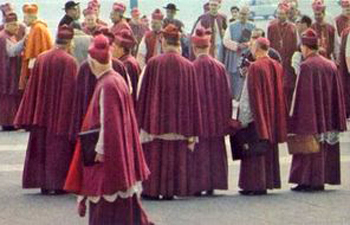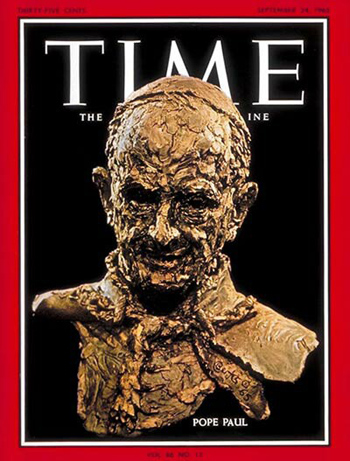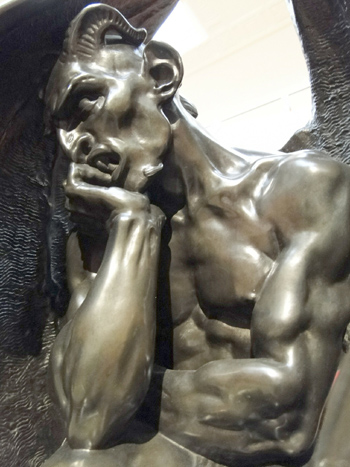Consequences of Vatican II
 |
 |
 |
 |
 |
 |
 |
The Great Moral Flaw in Vatican II - Part III
The Bishops Broke their Sworn
Oaths against Modernism
Given the blatant denial of the previous Magisterium made by the Bishops at the Council, as seen in the previous articles (here and
here), what are we to believe?
Are we to believe that those who voted in favor of the “counter-syllabus” documents of Vatican II, which were intended to “correct” the pronouncements of Popes Pius IX and St. Pius X (and presumably the pronouncements of Gregory XVI, Leo XIII, Pius XI, and Pius XII as well), violated the Oath against Modernism that they had taken? Are we to believe that they forgot their oath?
 In either case - and this is the great moral flaw in the Second Vatican Council - it is not possible to accept that the participants in Vatican II were cooperating with the Holy Spirit when they adopted measures inconsistent with the Oath against Modernism - an oath that they all had taken.
In either case - and this is the great moral flaw in the Second Vatican Council - it is not possible to accept that the participants in Vatican II were cooperating with the Holy Spirit when they adopted measures inconsistent with the Oath against Modernism - an oath that they all had taken.
This fact, if accepted, casts more than serious doubt both on the so-called “spirit of Vatican II” and on the very legitimacy of the entire Council’s “counter-syllabus” documents - documents that, according to Pope Benedict XVI, were intended to “correct” or “counter” teachings which all the participants in Vatican II were oath-bound to uphold.
Lest we are tempted to suggest that Pius IX and St. Pius X’s condemnations of Liberalism and Modernism were only addressed to an obscure set of beliefs of a few ultra-liberal theologians of that epoch, we are reminded of St. Pius X’s identification of the Modernism as “the synthesis of all heresies.” (1)
Also, a more contemporary admonition delivered by Paul VI on Modernism reminds us that it “is the most dangerous revolution the Church has ever had to face, and it is still scourging her severely.” (2) Paul VI went on to identify the Modernism that is “still” scourging the Church severely, implicitly describing it when he characterized it as a “revolution” within the Church: “This revolution is a process of self-demolition and it aims at driving the Church to the end of the road to perdition.”
The trinity of parents responsible for the perversion known as Modernism are: 1. Its religious ancestor, the Protestant Reformation; 2. Its philosophical parent, the Enlightenment; 3. Its political pedigree, which comes from the French Revolution. (3)
 Further, if we are to judge by the fruits of the Vatican II, what are we to believe? We have Paul VI’s own evaluation of the aftermath of the Council:
Further, if we are to judge by the fruits of the Vatican II, what are we to believe? We have Paul VI’s own evaluation of the aftermath of the Council:
“We looked forward to a flowering, a serene expansion of concepts which matured in the great sessions of the Council. … [Instead, ] it is as if the Church were destroying herself. (4)
“We have the impression that through some cracks in the wall the smoke of Satan has entered the temple of God: … doubt, uncertainty, questioning, dissatisfaction, confrontation … We thought that after the Council a day of sunshine would have dawned for the history of the Church. What dawned, instead, was a day of clouds and storms, of darkness, of searching and uncertainties.” (5)
The clouds, the storms, the darkness, the searching, the uncertainties - who can say that they are not still with us today, more than five decades after the close of Vatican II? If the Church herself is to judge the Council by its fruits, should she not heed Our Lord’s injunction given at the close of His Sermon on the Mount - “Every tree that bringeth not forth good fruit, shall be cut down, and shall be cast into the fire. Wherefore by their fruits you shall know them.” (Mt 7:19-20)
One comes to the conclusion that the cause of this described disaster was the decision to “counter” or “correct” those teachings that the Prelates at the Council were oath-bound to uphold. It is not a wonder that, in the wake of an oath-abandoning Council, it should appear that the smoke of Satan has entered the Temple of God.
If it is true - as Paul VI said - that the smoke of Satan has entered the Temple of God, and if it is true that the smoke of Satan crept into Vatican II with the abandoning of the Oath against Modernism, then it is high time that the smoke of Satan be swept away. Now is the time for higher minds with no other agenda except adherence to the eternal truths of the Catholic Faith to excise the Devil and to restore that Faith.
It was again Paul VI, the very Pope who presided over the adoption of the oath-tainted documents of the Council and began the process of implementing their dictates, who expressed the final verdict on it shortly before his death. These were his words:
“The tail of the Devil is functioning in the disintegration of the Catholic world. The darkness of Satan has entered and spread throughout the Catholic Church even to its summit. Apostasy, the loss of the faith, is spreading throughout the world and into the highest levels inside the Church.” (6)
Was Paul VI just “whistling Dixie”? Or was he, in his final days, admitting something important?
It is becoming impossible to deny that the tree that bore the fruits of that violation of the Oath against Modernism is Vatican II itself. It is simply not possible to affirm that the Holy Spirit somehow oversaw and countenanced the violation of an oath taken to God himself.
One cannot help recalling Card. Ratzinger’s words:
“Not every valid council in the history of the Church has been a fruitful one; in the last analysis many of them have been just a waste of time,” and “The last word about the historical value of Vatican Council II has yet to be spoken.” (7)
Jesus Himself has told us what must be done, in no uncertain terms, about unfruitful trees and, presumably, about unfruitful councils: “Every tree that bringeth not forth good fruit, shall be cut down, and shall be cast into the fire.” (Mt 7:19)
The simple, yet astonishingly difficult-to-accept implication is that “the clouds, the storms, the darkness” that Paul VI saw besetting the Church - and that still beset the Church today (exemplified and multiplied by the once-unthinkable sex scandals) - must continue until the Church repudiates all the changes and innovations wrought by the Council participants’ abandonment of their oath-bound obligations to oppose Modernism.
Raymond B. Marcin is Professor of Law Emeritus
Columbus School of Law
The Catholic University of America
Washington, DC

Are we to believe that those who voted in favor of the “counter-syllabus” documents of Vatican II, which were intended to “correct” the pronouncements of Popes Pius IX and St. Pius X (and presumably the pronouncements of Gregory XVI, Leo XIII, Pius XI, and Pius XII as well), violated the Oath against Modernism that they had taken? Are we to believe that they forgot their oath?

Each Bishop at Vatican II swore the Oath against Modernism; all broke it
This fact, if accepted, casts more than serious doubt both on the so-called “spirit of Vatican II” and on the very legitimacy of the entire Council’s “counter-syllabus” documents - documents that, according to Pope Benedict XVI, were intended to “correct” or “counter” teachings which all the participants in Vatican II were oath-bound to uphold.
Lest we are tempted to suggest that Pius IX and St. Pius X’s condemnations of Liberalism and Modernism were only addressed to an obscure set of beliefs of a few ultra-liberal theologians of that epoch, we are reminded of St. Pius X’s identification of the Modernism as “the synthesis of all heresies.” (1)
Also, a more contemporary admonition delivered by Paul VI on Modernism reminds us that it “is the most dangerous revolution the Church has ever had to face, and it is still scourging her severely.” (2) Paul VI went on to identify the Modernism that is “still” scourging the Church severely, implicitly describing it when he characterized it as a “revolution” within the Church: “This revolution is a process of self-demolition and it aims at driving the Church to the end of the road to perdition.”
The trinity of parents responsible for the perversion known as Modernism are: 1. Its religious ancestor, the Protestant Reformation; 2. Its philosophical parent, the Enlightenment; 3. Its political pedigree, which comes from the French Revolution. (3)

What could Paul VI expect for the Church from a Council of perjurers except the smoke of Satan?

“We looked forward to a flowering, a serene expansion of concepts which matured in the great sessions of the Council. … [Instead, ] it is as if the Church were destroying herself. (4)
“We have the impression that through some cracks in the wall the smoke of Satan has entered the temple of God: … doubt, uncertainty, questioning, dissatisfaction, confrontation … We thought that after the Council a day of sunshine would have dawned for the history of the Church. What dawned, instead, was a day of clouds and storms, of darkness, of searching and uncertainties.” (5)
The clouds, the storms, the darkness, the searching, the uncertainties - who can say that they are not still with us today, more than five decades after the close of Vatican II? If the Church herself is to judge the Council by its fruits, should she not heed Our Lord’s injunction given at the close of His Sermon on the Mount - “Every tree that bringeth not forth good fruit, shall be cut down, and shall be cast into the fire. Wherefore by their fruits you shall know them.” (Mt 7:19-20)
One comes to the conclusion that the cause of this described disaster was the decision to “counter” or “correct” those teachings that the Prelates at the Council were oath-bound to uphold. It is not a wonder that, in the wake of an oath-abandoning Council, it should appear that the smoke of Satan has entered the Temple of God.
If it is true - as Paul VI said - that the smoke of Satan has entered the Temple of God, and if it is true that the smoke of Satan crept into Vatican II with the abandoning of the Oath against Modernism, then it is high time that the smoke of Satan be swept away. Now is the time for higher minds with no other agenda except adherence to the eternal truths of the Catholic Faith to excise the Devil and to restore that Faith.
It was again Paul VI, the very Pope who presided over the adoption of the oath-tainted documents of the Council and began the process of implementing their dictates, who expressed the final verdict on it shortly before his death. These were his words:
“The tail of the Devil is functioning in the disintegration of the Catholic world. The darkness of Satan has entered and spread throughout the Catholic Church even to its summit. Apostasy, the loss of the faith, is spreading throughout the world and into the highest levels inside the Church.” (6)
Was Paul VI just “whistling Dixie”? Or was he, in his final days, admitting something important?
It is becoming impossible to deny that the tree that bore the fruits of that violation of the Oath against Modernism is Vatican II itself. It is simply not possible to affirm that the Holy Spirit somehow oversaw and countenanced the violation of an oath taken to God himself.
One cannot help recalling Card. Ratzinger’s words:
“Not every valid council in the history of the Church has been a fruitful one; in the last analysis many of them have been just a waste of time,” and “The last word about the historical value of Vatican Council II has yet to be spoken.” (7)
Jesus Himself has told us what must be done, in no uncertain terms, about unfruitful trees and, presumably, about unfruitful councils: “Every tree that bringeth not forth good fruit, shall be cut down, and shall be cast into the fire.” (Mt 7:19)
The simple, yet astonishingly difficult-to-accept implication is that “the clouds, the storms, the darkness” that Paul VI saw besetting the Church - and that still beset the Church today (exemplified and multiplied by the once-unthinkable sex scandals) - must continue until the Church repudiates all the changes and innovations wrought by the Council participants’ abandonment of their oath-bound obligations to oppose Modernism.
Columbus School of Law
The Catholic University of America
Washington, DC
- St. Pius X, Pascendi Dominici Gregis (On Modernism), 1907, para. 39 (emphasis added).
- Apud Ted and Maureen Flynn, The Thunder of Justice 222 (1993) (emphasis added). For an analysis of the heresy of Modernism, see Raymond B. Marcin, “The Heresy of Modernism,” The Latin Mass: The Journal of Catholic Culture and Tradition, Spring, 2006, p. 36
- Apud Ted and Maureen Flynn, The Thunder of Justice 222 (1993).
- Paul VI, Address to Lombard College, December 7, 1968
- Paul VI, Address on the Ninth Anniversary of His Pontificate, June 29, 1972.
- Paul VI, Address on the Sixtieth Anniversary of the Fatima Apparitions, October 13, 1977 (emphasis added).
- Joseph Ratzinger, Principles of Catholic Theology: Building Stones for a Fundamental Theology, (San Francisco: Ignatius Press 1987), p. 378.

Posted March 21, 2014














